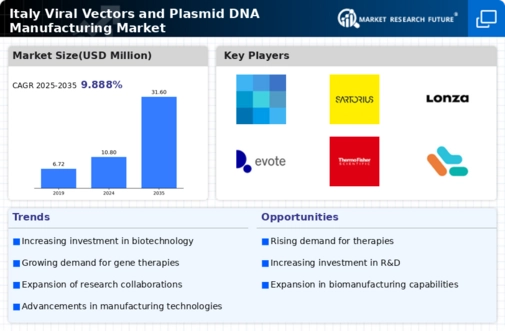Growing Applications in Vaccines
The Global Italy Viral Vectors and Plasmid DNA Manufacturing Market Industry is witnessing a growing application of viral vectors and plasmid DNA in vaccine development. The versatility of these technologies allows for the creation of effective vaccines against various infectious diseases. As the global health landscape evolves, the demand for innovative vaccine solutions is increasing. This trend is further supported by the need for rapid vaccine development in response to emerging health threats. The market is expected to expand as manufacturers focus on leveraging viral vectors and plasmid DNA to create next-generation vaccines, thereby enhancing public health outcomes.
Rising Demand for Gene Therapies
The Global Italy Viral Vectors and Plasmid DNA Manufacturing Market Industry is experiencing a surge in demand for gene therapies, driven by advancements in genetic engineering. As of 2024, the market is valued at approximately 1250 USD Million, reflecting the increasing interest in personalized medicine. The potential of viral vectors in delivering therapeutic genes is being recognized by biopharmaceutical companies, leading to a robust pipeline of gene therapy products. This trend is expected to continue, with the market projected to reach 3750 USD Million by 2035, indicating a compound annual growth rate (CAGR) of 10.5% from 2025 to 2035.
Increased Investment in Biotechnology
The Global Italy Viral Vectors and Plasmid DNA Manufacturing Market Industry is benefiting from increased investment in biotechnology research and development. Governments and private investors are channeling funds into biopharmaceutical companies focusing on innovative therapies. This influx of capital is fostering an environment conducive to research, leading to the development of new viral vector technologies and plasmid DNA applications. The financial support enhances the capabilities of manufacturers, allowing them to expand their production capacities and improve product offerings. As the biotechnology sector continues to thrive, the demand for viral vectors and plasmid DNA is expected to rise correspondingly.
Regulatory Support for Advanced Therapies
Regulatory bodies are increasingly supportive of advanced therapies, which is positively impacting the Global Italy Viral Vectors and Plasmid DNA Manufacturing Market Industry. Streamlined approval processes for gene therapies and biologics are encouraging manufacturers to invest in the development of innovative products. This regulatory environment fosters collaboration between industry stakeholders and regulatory agencies, facilitating the introduction of new therapies to the market. As regulations evolve to accommodate the unique challenges of gene therapy development, the market is likely to see accelerated growth, with manufacturers poised to capitalize on these opportunities.
Technological Advancements in Manufacturing
Technological innovations in the production of viral vectors and plasmid DNA are significantly influencing the Global Italy Viral Vectors and Plasmid DNA Manufacturing Market Industry. Enhanced manufacturing processes, such as improved cell culture techniques and purification methods, are enabling higher yields and better quality products. These advancements not only reduce production costs but also increase the efficiency of viral vector production. As a result, companies are better positioned to meet the growing demand for gene therapies and vaccines, contributing to the market's growth trajectory. The focus on automation and process optimization is likely to further propel the market forward.






















Leave a Comment